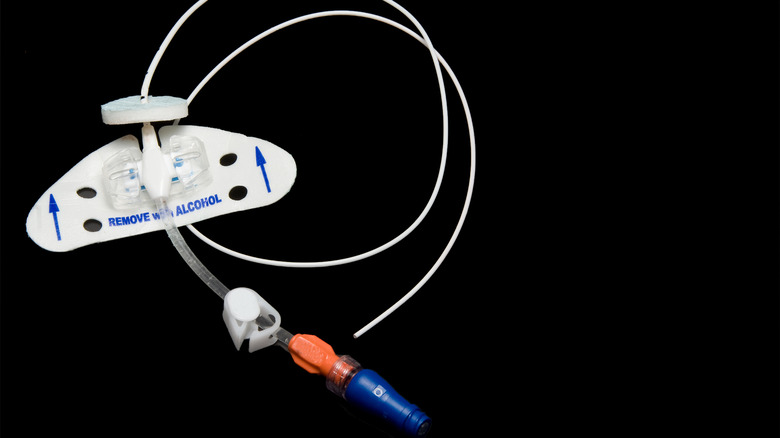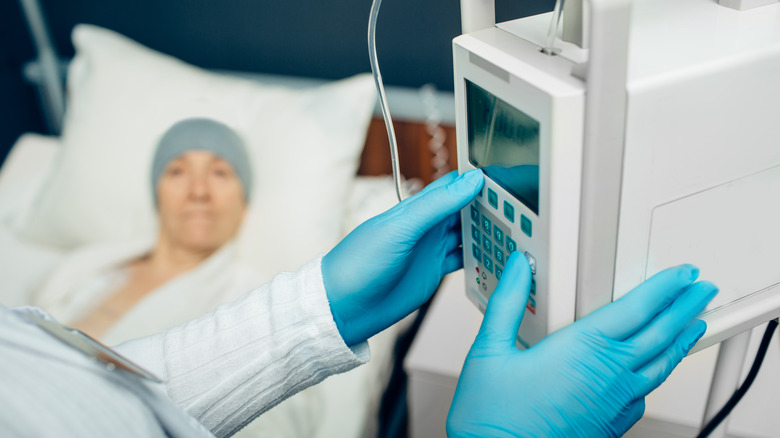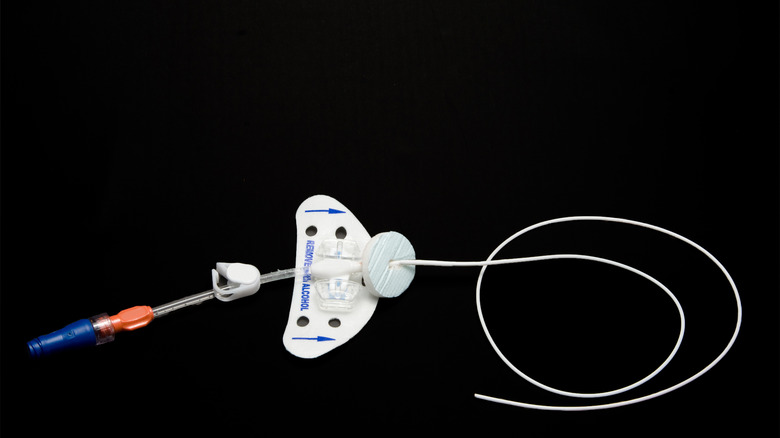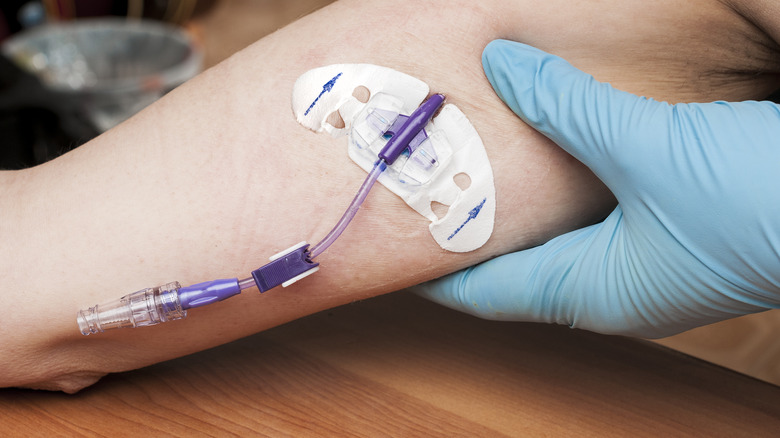What Is A PICC Line, And What Does It Do?
According to the Mayo Clinic, PICC stands for peripherally inserted central catheter. This long, thin tube gives doctors access to various veins near the heart. The PICC line is usually inserted through a vein in the arm and goes up all the way to the larger veins near the heart.
The opening of the PICC (on the other end of the line) stays outside the body and is used to draw blood or administer medications and fluids (via Medical News Today). While insertion is typically done through the arm, there are rare cases where the PICC line may be placed in the leg, says the Mayo Clinic.
Generally speaking, PICC lines offer several benefits over other IV treatments. However, risks are also present — careful monitoring is needed with patients using PICC lines. This helps prevent and treat any complications that may arise, says the Mayo Clinic. Furthermore, preparation and adjustments are needed before, during, and after the insertion.
Why are PICC lines used?
Since PICC lines deliver various substances (including medications and fluids) directly into the large central veins near the heart, they are usually used for patients whose treatment plans would otherwise require frequent needle pricks. The PICC line is meant to be temporary and may be used for treatments that last up to several weeks or even longer, says the Mayo Clinic.
One example is cancer treatment. According to Medical News Today, cancer treatments often use the peripheral IV line (PIV). But since they can't administer all types of chemotherapy, PICC lines are often used.
If you have trouble absorbing various nutrients, PICC lines can also be used to administer liquid nutrition, says Nemours Kids Health. This is useful if your body cannot adequately and completely process nutrients from regular food. Also, if you have a serious infection, your doctor might use a PICC line to administer antibiotics and antifungal medicine, notes Mayo Clinic.
What are the risks associated with a PICC line?
PICC lines are generally safe and low-risk. However, the procedure and usage of the PICC line come with some risks. Although rare, accidental puncturing of an artery or nerve can happen during the insertion, says the Cleveland Clinic.
Also, the PICC line might move out of place or come out partially or completely if it's not well secured or covered (via the Mayo Clinic).
Other risks include infections and blood clots. According to Nemours Kids Health, blood clots are a very rare occurrence. However, when they do occur, they can cause pain and swelling in the arm, says the Cleveland Clinic.
Phlebitis is another risk mentioned by the clinic. This refers to an inflamed vein. Such inflammation is uncomfortable and can have dangerous consequences in some cases, but according to the Cleveland Clinic, this risk can develop from all types of IVs and not just the PICC line.
What are the benefits of a PICC line?
Even though the insertion process can be mildly uncomfortable, using the PICC line can be more convenient than receiving many different needle sticks, says Medical News Today. According to the source, patients can receive multiple medications or treatments at once, since PICC lines can have various lumens (caps and tubings).
Another important benefit associated with the use of PICC lines is how easy it is with regard to blood tests. According to Nemours Kids Health, it reduces the risk that comes with having too many needle pricks, as well as the number of needle sticks needed for a blood draw. This is a plus that is especially beneficial for children.
In addition, medications (such as chemotherapy medicines) and fluids can be administered in larger amounts which might be unsuitable for standard IVs, says Nemours Kids Health.
According to the Cleveland Clinic, the line can also be used either at home or in the hospital. Once inserted properly, it stays in place for weeks or months, as needed.
How is the procedure performed?
Procedures using PICC lines often begin with a blood test. According to the Mayo Clinic, blood tests might be required to help your doctor understand how many blood clotting cells (platelets) you have. Too few platelets might increase the risk of bleeding, initiating the need for medicine or a blood transfusion (to increase your platelet level) before the PICC line is inserted.
According to Mayo Clinic, a consultation will help your doctor gain insight into your health, since PICC lines aren't recommended for everyone, especially those with a history of kidney disease. Along with a consultation, your doctor might request various imaging tests (including ultrasound or x-ray) to plan for the insertion using images of your veins, says the clinic.
For the line to be inserted, you will be asked to lie on your back. According to MedlinePlus, a strap will be tied around your arm, and once a vein is chosen, the area will be cleaned. To minimize pain, you will be given a shot of numbing medicine.
A needle is inserted into the vein, followed by a catheter, says the Mayo Clinic. The catheter is then guided carefully through the vein to its proper spot, and then connected to another catheter that remains outside the body, notes MedlinePlus.
Once the PICC line is in place, a special tape will be used to hold the line to your arm, and then it is covered with a sterile dressing, according to the Cleveland Clinic.
What to expect after the procedure
After a PICC line insertion, you might notice some tenderness at the point of insertion, which should resolve within a few days, says the Mayo Clinic. According to MedlinePlus, mild pain and swelling might occur around the site for two to three weeks, hence the need to avoid exerting yourself.
The source advises against lifting anything with that arm, or engaging in any strenuous activities, for two weeks. It's also important to monitor your temperature daily. If you develop a fever, reach out to your doctor.
When it comes to bathing, it's always best to stick to your doctor's instructions. As a guide, MedlinePlus says it's typically okay to start taking showers and baths after a few days, but recommends consulting your doctor about the best time to begin after the procedure.
When you take showers and baths, the source recommends keeping the dressings secure and the catheter site dry. According to the Mayo Clinic, PICC line covers are available for protection when bathing.
According to the Children's Hospital of Philadelphia, the PICC line can stay put for weeks to months, provided it is properly cared for. In general, it's usually kept in for as long as treatment is needed.
Removal is a more simple process, says the Mayo Clinic. According to the clinic, the end of the catheter is pulled gently by your healthcare provider to remove it from the arm.






